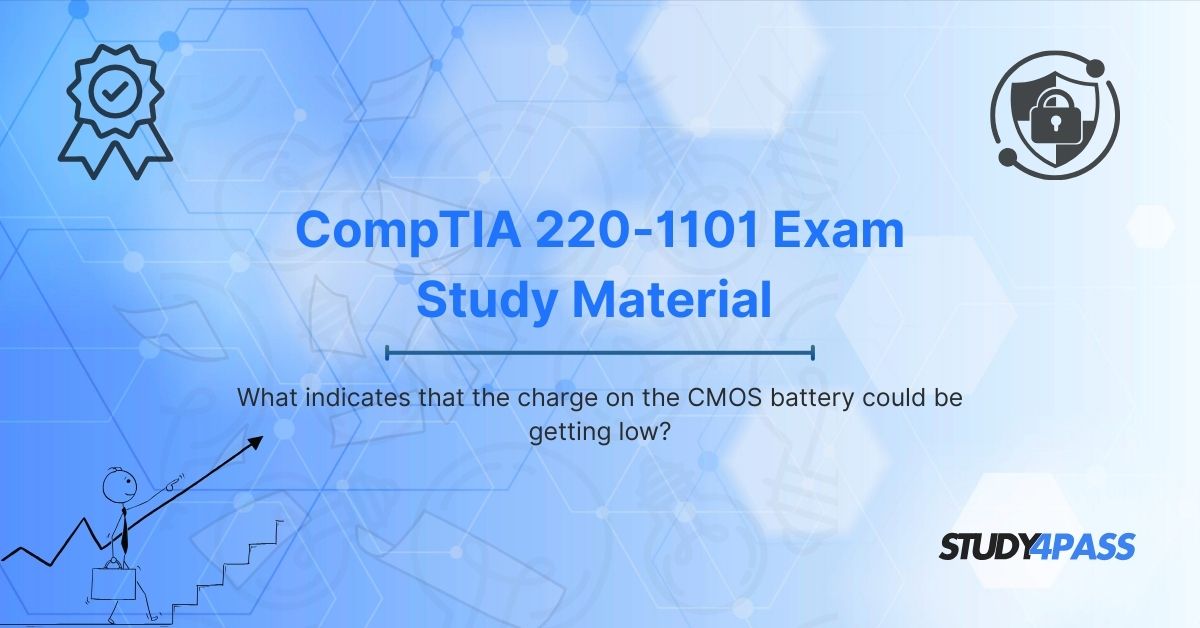Introduction
The CMOS (Complementary Metal-Oxide-Semiconductor) battery is a crucial component in a computer’s motherboard. It powers the BIOS/UEFI firmware settings, ensuring that the system retains critical configuration data such as date, time, and hardware settings even when the computer is turned off. When the CMOS battery starts losing its charge, several symptoms begin to appear, affecting system performance and stability.
For IT professionals and CompTIA A+ certification candidates, understanding these signs is essential for troubleshooting hardware issues. This article explores the key indicators of a failing CMOS battery, how to diagnose the problem, and best practices for replacement. Additionally, we recommend Study4Pass as an excellent resource for CompTIA A+ exam preparation, offering high-quality study materials and practice tests.
Symptoms of a Failing CMOS Battery
1. Incorrect System Date and Time
One of the most common signs of a weak CMOS battery is the system displaying the wrong date and time. Since the CMOS battery maintains the Real-Time Clock (RTC), a failing battery causes the clock to reset to a default date (often January 1st, 1970, or another early timestamp) every time the computer restarts.
2. BIOS/UEFI Settings Reset to Default
If BIOS or UEFI settings (such as boot order, secure boot, or hardware configurations) revert to default values after a shutdown, the CMOS battery may be losing charge. This happens because the motherboard cannot retain custom settings without sufficient power.
3. Failure to Boot or POST Errors
A critically low CMOS battery can cause boot failures or Power-On Self-Test (POST) errors. The system may display messages like:
- "CMOS Battery Failure"
- "CMOS Checksum Error"
- "Default BIOS settings loaded"
These errors indicate that the BIOS cannot retain configuration data, forcing a reset to factory defaults.
4. Hardware Detection Issues
A weak CMOS battery may lead to intermittent hardware detection problems. The system might fail to recognize storage drives, RAM, or peripherals, requiring repeated BIOS resets.
5. Frequent System Crashes or Freezes
In some cases, an unstable CMOS battery can cause system instability, leading to random crashes, freezes, or unexpected shutdowns.
6. Continuous Beeping Sounds from Motherboard
Some motherboards emit beep codes when hardware issues arise. A failing CMOS battery might trigger a specific beep pattern, indicating a BIOS-related problem.
How to Diagnose a Failing CMOS Battery?
1. Check System Date and Time
If the date and time reset after a reboot, the CMOS battery is likely dying.
2. Enter BIOS/UEFI and Observe Settings
Restart the computer and enter BIOS/UEFI (usually by pressing Del, F2, or F12 during boot). If settings frequently reset, the battery may need replacement.
3. Use a Multimeter to Test Voltage
A healthy CMOS battery (typically a CR2032 coin cell) should provide 3V. If the voltage drops below 2.7V, it’s time to replace it.
4. Inspect for Physical Damage
Check the battery for corrosion, leakage, or loose connections. A damaged battery must be replaced immediately.
How to Replace a CMOS Battery?
- Power Off and Unplug the System – Ensure the computer is completely shut down.
- Open the Case – Remove the side panel to access the motherboard.
- Locate the CMOS Battery – It’s a small, round, silver battery (CR2032) on the motherboard.
- Remove the Old Battery – Gently push the retaining clip and slide the battery out.
- Insert the New Battery – Place the new CR2032 battery with the positive side facing up.
- Reassemble and Power On – Close the case, reconnect power, and enter BIOS to reconfigure settings.
Why Study4Pass is Ideal for CompTIA A+ Exam Preparation?
Preparing for the CompTIA A+ 220-1101 exam requires reliable study materials and practice tests. Study4Pass offers:
- Comprehensive Study Guides – Covers all exam objectives in detail.
- Realistic Practice Tests – Simulates actual exam conditions.
- Expert Explanations – Helps reinforce key concepts.
- Up-to-Date Content – Aligns with the latest CompTIA A+ syllabus.
By using Study4Pass, candidates can confidently prepare for the exam, ensuring a higher chance of passing on the first attempt.
Conclusion
A failing CMOS battery can cause various system issues, including incorrect time, BIOS resets, and boot failures. Recognizing these symptoms early helps maintain system stability. For IT professionals pursuing CompTIA A+ certification, understanding CMOS battery troubleshooting is essential.
For top-notch exam preparation, Study4Pass provides excellent study materials and practice tests, making it a valuable resource for aspiring A+ certified technicians.
Special Discount: Offer Valid For Limited Time “220-1101 Exam Material”
Actual Exam Questions For CompTIA's 220-1101 Study Guide
Sample Questions For CompTIA 220-1101 Practice Test
1. What is a common symptom of a low CMOS battery?
a) The computer boots faster than usual
b) The system time and date reset frequently
c) The monitor displays brighter colors
d) The hard drive storage increases
2. Which of the following errors may appear if the CMOS battery is weak?
a) "No internet connection" error
b) "CMOS checksum error" or "CMOS battery failure"
c) "Graphics card not detected"
d) "Keyboard not found"
3. What happens to BIOS settings when the CMOS battery is dying?
a) They remain unchanged
b) They get corrupted and cannot be fixed
c) They reset to default values after power loss
d) They automatically update to the latest version
4. If a computer consistently fails to remember hardware configurations, what component might need replacement?
a) RAM
b) Power supply unit
c) CMOS battery
d) GPU
5. Which of the following is NOT a sign of a failing CMOS battery?
a) Frequent BIOS password reset
b) System clock running slow or incorrect
c) Blue screen errors with memory-related codes
d) Loss of customized BIOS settings


